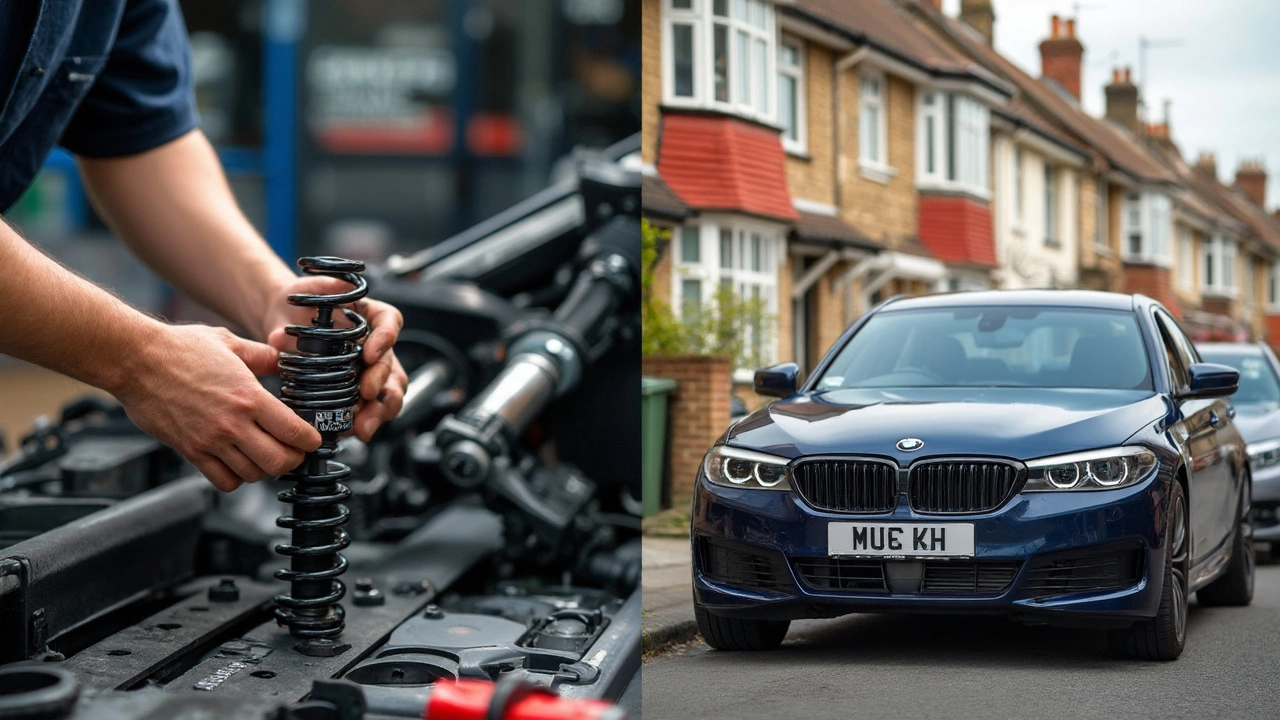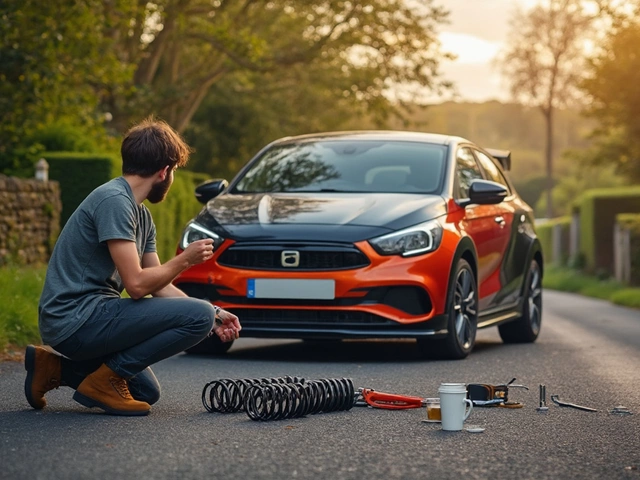You’re eyeing that dropped stance, but which way should you go—lowering springs or coilovers? Both slam your car closer to the pavement, but they’re totally different animals.
Lowering springs are the no-fuss pick—they swap into your factory setup, cut your wheel gap, and boom: sportier look, a little sharper on those corners. Coilovers? Whole different beast. You get height adjustment, you can dial in how stiff or soft you want the ride, and your car suddenly feels way more custom. But it also means more choices and, yeah, a bigger hit to your wallet.
Before you drop cash, you need to know what really fits your car, your budget, and how much you actually care about ride quality versus looks. If you’re chasing that perfect blend of daily comfort and weekend fun, picking the wrong option can wreck your back—or your paycheck.
- What Are Lowering Springs and Coilovers?
- Ride Quality and Handling Differences
- Cost, Installation, and Upkeep
- Who Should Pick Springs? Who Should Go Coilovers?
- Real-World Tips Before You Buy
What Are Lowering Springs and Coilovers?
Let’s clear up the basics so you know what you’re actually bolting onto your car. Lowering springs are pretty much what the name says: shorter, stiffer springs that take the place of your stock ones. They drop your car’s height—usually between one and two inches. This gets rid of that goofy wheel gap and gives the car better handling, at least on smooth roads. They reuse your factory shocks, so installation is straightforward and the price stays low.
Coilovers, on the other hand, are a full suspension setup—shock and spring together as one unit. The cool part is they come with adjustable collars, so you decide how low (or high) your car sits. Most let you tweak the stiffness too. Some even come with camber plates for dialing in alignment. You get more control, and your car can go from street-friendly to track-ready with a few turns of a wrench.
Here’s a quick breakdown of the main differences:
- Lowering Springs: Shorter springs, reuses factory shocks, budget-friendly, fixed drop height, less adjustability.
- Coilovers: Complete assembly, shocks included, height and sometimes damping adjustable, more expensive, better for fine-tuning both look and performance.
Main thing to remember: lowering springs are simple and cheap, coilovers are pricey but loaded with options. Your choice mostly depends on how picky you are and how much you’re ready to spend.
Ride Quality and Handling Differences
Here’s where you really start to see the split between lowering springs and coilovers. It’s not just about how low your car sits—it's about how it actually drives and feels every day.
Lowering springs usually swap straight onto your stock shocks and struts. You’ll get a firmer, sometimes bouncier ride, but it’s often still comfy enough for daily commuters. Springs are pre-set, so you can’t exactly tweak the stiffness. The big thing? They mostly just make the car stiffer because they’re shorter and sometimes come with higher spring rates. For most folks, daily driving feels sportier right away, but you might notice more bumps and jolts, especially if the roads in your area are gnarly.
Coilovers are a game changer if you want more control. We're talking adjustable ride height, and with many setups, even adjustable damping (how stiff or soft it feels). This means you can tune for weekends at the track, then dial it back for groceries on Monday. The tradeoff is that with cheaper coilovers, ride quality tanks fast if you set them too stiff, and cheap kits can even feel worse than stock with springs. Get a good brand though, and you’ll honestly feel the difference—especially in corners and fast lane changes. Some brands brag about handling boosts of over 20% in lateral grip compared to stock setups.
| Type | Ride Comfort | Adjustability | Handling Improvement |
|---|---|---|---|
| Lowering Springs | Moderate | None | Noticeable |
| Coilovers | Variable (by setup) | Height & Stiffness | Significant (with good kit) |
One tip: if your area is full of potholes or your main goal is comfy daily driving, stick with quality lowering springs and lowering springs-compatible shocks. If you love track days, autocross, or dialing things in perfectly, coilovers are tough to beat. Cheap out on either, and you're probably not going to be happy with the result.

Cost, Installation, and Upkeep
If you’re staring at your bank balance wondering what this little adventure will cost, here’s the real talk. Lowering springs are the budget option. They typically run between $150 and $400 for a set. That covers all four corners, and you’re just swapping springs onto your stock shocks. If you’re paying a shop to do it, installation might set you back another $200 to $300, since it’s a pretty standard job for most mechanics.
Coilovers, though, are a totally different spend. Decent entry-level coilovers start around $700, but if you want adjustable damping, better ride quality, or go with a fancy brand, don’t be shocked if you’re looking at $1,200 to $2,000 before install. Labor tends to be a bit more expensive too—installation can run $400 or more since there’s more stuff to line up and settings to dial in right.
| Option | Parts Cost (Set of 4) | Average Install | Extra Upkeep |
|---|---|---|---|
| Lowering Springs | $150-$400 | $200-$300 | Change stock shocks over time |
| Coilovers | $700-$2,000 | $400+ | Lubrication, adjust, occasional rebuild |
Upkeep is easier on springs. You install them and, unless they wear out, you pretty much forget about them. But if you pair lowering springs with old, original shocks, expect those shocks to quit faster from the extra stress. That means you might have to swap out struts sooner than you’d like.
Coilovers need more love. Road grime, salt, or just rough weather can mess with the threads (which is how you adjust the ride height), so a shot of lubricant every few months is smart. If you’re constantly playing with settings or hitting potholes, some parts could wear down and need rebuilding. Not hard, but you can’t ignore it like you would with regular springs.
Bottom line? If you want set-and-forget, lowering springs are simple and wallet-friendly. If you want options and don’t mind paying (and maintaining) for them, coilovers open up a whole world of adjustability.
Who Should Pick Springs? Who Should Go Coilovers?
If you’re just looking for an easy way to drop your ride and don’t want to mess with settings every other weekend, lowering springs are about as plug-and-play as it gets. They’re for the driver who wants a lower stance—maybe get rid of that ugly wheel gap, maybe look a bit meaner—without spending a ton or dealing with complicated adjustments. Daily commuters, people who only drive on normal streets, or anyone on a budget will probably feel right at home with a solid set of lowering springs.
Lowering springs also make sense if you don’t race and you’re okay with the ride getting a little stiffer. Good brands like Eibach or H&R usually drop your car around 1–2 inches, just enough to improve looks and handling without totally killing the ride comfort or needing expensive extras like camber kits.
On the flip side, coilovers are all about flexibility and control. Let’s say you want to tweak ride height for car shows or track days, or you’re really picky about handling. With a good set of coilovers, like KW, BC Racing, or Fortune Auto, you can adjust both how low you go and how the car handles bumps. Some coilovers even let you set damping, so you can go soft for a road trip and stiff for spirited driving—all with a quick twist of a knob.
Coilovers are for people who love dialing in their car, folks who hit track events, or anyone itching to swap wheel setups or make height changes often. They’re also the pick if you want to run more aggressive wheels or need extra clearance. Just keep in mind, all those adjustments bump up the price. You’re also looking at longer install times and sometimes more maintenance—especially if you live somewhere with salty winters.
- Pick lowering springs if you want a quick, affordable height drop and mostly drive on normal roads.
- Go coilovers if you need adjustability for height, damping, or do a lot of performance driving.
- Check your local roads: rougher streets mean stiffer setups can get annoying fast.
- If you’re not handy with tools or don’t want to pay a shop a few hours of labor, springs are way easier to install.
So, figure out where you drive, how much fiddling you want, and what your budget really is before you pull the trigger on either setup.

Real-World Tips Before You Buy
If you’re actually looking to swap your suspension, it pays to plan ahead. Don't just grab the shiniest kit online—there are some big things to check before you pull the trigger.
- Check your car’s compatibility. Not everything fits every ride. Lowering springs are usually made for specific models, and some cars just won’t play nice with aggressive drops on their stock shocks.
- Think about your local roads. If you spend most days dodging potholes or driving on rough streets, a super-stiff setup (especially cheap coilovers) might make you regret life. Springs typically offer a milder, less back-breaking ride, at least if paired with decent shocks.
- Budget for extras. You might need a realignment after installation—no way around it if you want to avoid weird tire wear. Also, if your shocks are worn, replacing them along with springs is smart, even though it costs more upfront.
- Be honest about how much adjustability you’ll use. Coilovers sound cool, but most folks set them up once and never touch the dials again. Springs do what they do, and that’s it—you save money and stress if you’re not keen on tweaking every weekend.
- Warranty and brand reputation matter. Cheap off-brand coilovers can corrode within a year. Top brands, even for springs, give better customer support and usually longer warranties.
Just to give you some hard numbers, let’s compare real costs, installation time, and maintenance in this handy table:
| Lowering Springs | Coilovers | |
|---|---|---|
| Average Price (USD) | $150–$400 | $700–$2,500 |
| Install Time | 2–4 hours | 4–7 hours |
| Alignment Needed? | Yes | Yes |
| Adjustability | No | Height & stiffness |
| Maintenance | Low | Medium–High |
And here's a tip most people skip: always keep your original suspension parts stashed away. If you ever need to return the car to stock (maybe you’re selling, or need to pass inspection), you’ll be glad you saved them.




